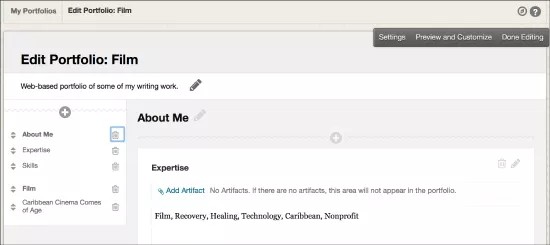This information applies only to the Original experience.
Looking for the latest release notes? View release notes for the portfolios tool.
Portfolios are an invaluable tool in academic and professional development. They provide a powerful medium for users to efficiently collect and organize artifacts representative of work completed over time. Portfolios offer a means to demonstrate formative and/or summative progress and achievement. Portfolio authors are empowered with tools to effectively present their information in a cohesive, personalized format.
There's no portfolio assignment type in Ultra courses.
More on how students use portfolios i Originals
More on how instructors use portfolios in Original.
Edit Portfolio settings
Administrators can edit portfolio settings from the Administrator Panel. These settings allow administrators to set access guidelines and general system availability for portfolios.
- On the Administrator Panel in the Tools and Utilities section, select Portfolios.
Select Portfolio Settings. The following table describes the available fields.
Portfolio Settings and Descriptions Field Description General Portfolio Availability System Availability Select Yes or No to make portfolios available in the system. If you make portfolios available, select the user roles that may create portfolios. Available to Select the Everyone option to make portfolios available to all users in the system.
For Selected Roles, select which roles have access to portfolios. Use the arrows to move these roles into and out of the Selected Roles list.
Manage user portfolios
- On the Administrator Panel, under Tools, select Portfolios.
- Select Manage Portfolios.
- Provide or Browse for a username.
- Select Submit.
- The user's My Portfolios page appears, and from there administrators can manage all portfolios belonging to that user.
Administrators can create templates for portfolios. Portfolio templates define the structure and style of portfolios, leaving it to users to populate the portfolio with appropriate artifacts. Templates are useful for applying a standard structure to ensure that user portfolios meet the educational goals for the portfolio.
When creating portfolios, users can select a template so they have a starting point.
Create a personal portfolio template
- On the Administrator Panel in the Tools section, select Portfolios.
- Select Create Template.
- Type a title for the portfolio. The title appears at the top of the portfolio. Optionally, provide a description and instructions.
- Select the template content settings and availability.
- Select Submit. The template opens for editing.
The first time you create a portfolio, you have the option of taking a brief guided tour of the portfolio authoring canvas. If you choose to skip or replay the tour, you can select the compass icon to view it later.
To customize the portfolio template's header and footer, select the pencil icon.
A portfolio consists of pages and sections. Use a page to provide structure to the portfolio. Each page must have at least one section. Use a section to provide structure to the page's content.
The menu shows all of the portfolio's pages and sections, which you can use to manage them. Select the plus icon at the top of the menu to add pages and sections. To delete pages, select the trash can icon to the right of a page.
Deleting a page also deletes all of the sections and content on that page. Artifacts associated with a section remain in the My Artifacts repository, and you can reuse them.
Use the drag-and-drop function to rearrange pages and sections in the menu. During authoring, use the menu to move among pages to edit them.
Select the pencil icon next to a section title to edit it. Each section has a content editor for creating freeform content. The content editor appears when you select the content editor box. You can associate one or more artifacts with each section. Typically, you add artifacts to a section and use the content editor to reflect on those artifacts.
The Settings option allows you to change the decisions made when creating the portfolio, such as the portfolio title and description.
The Preview and Customize option lets you to see how the portfolio will look, and make layout and color palette decisions that affect the final design of the portfolio.
Select Done Editing when you're finished. If you try to exit without saving new and updated content, you're warned of unsaved changes.

